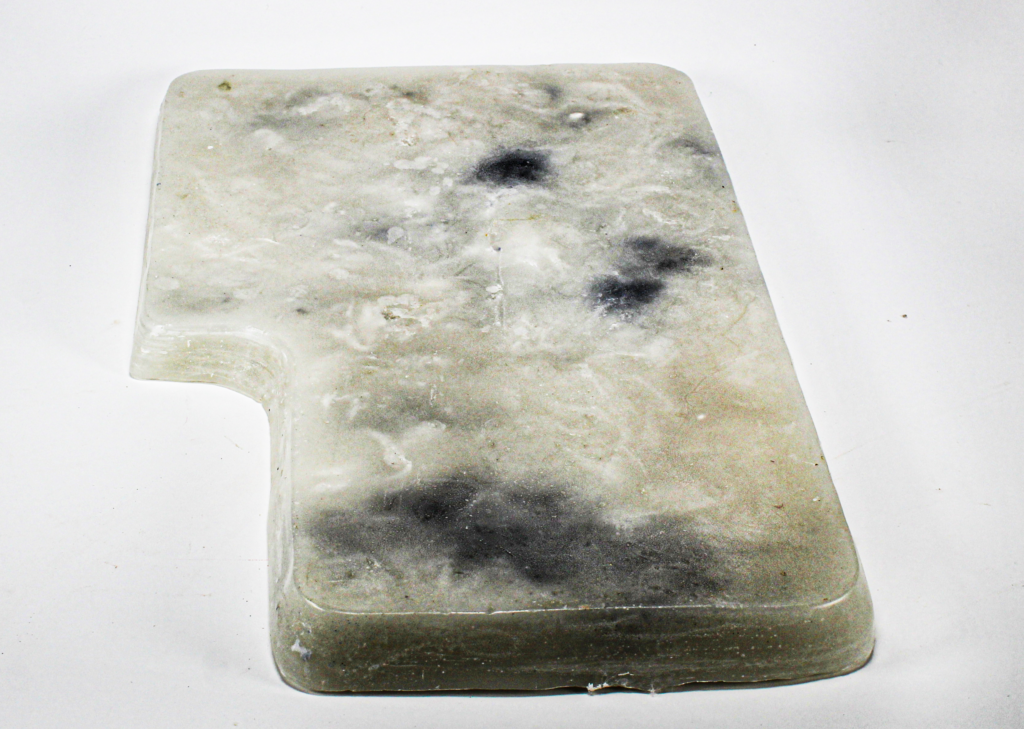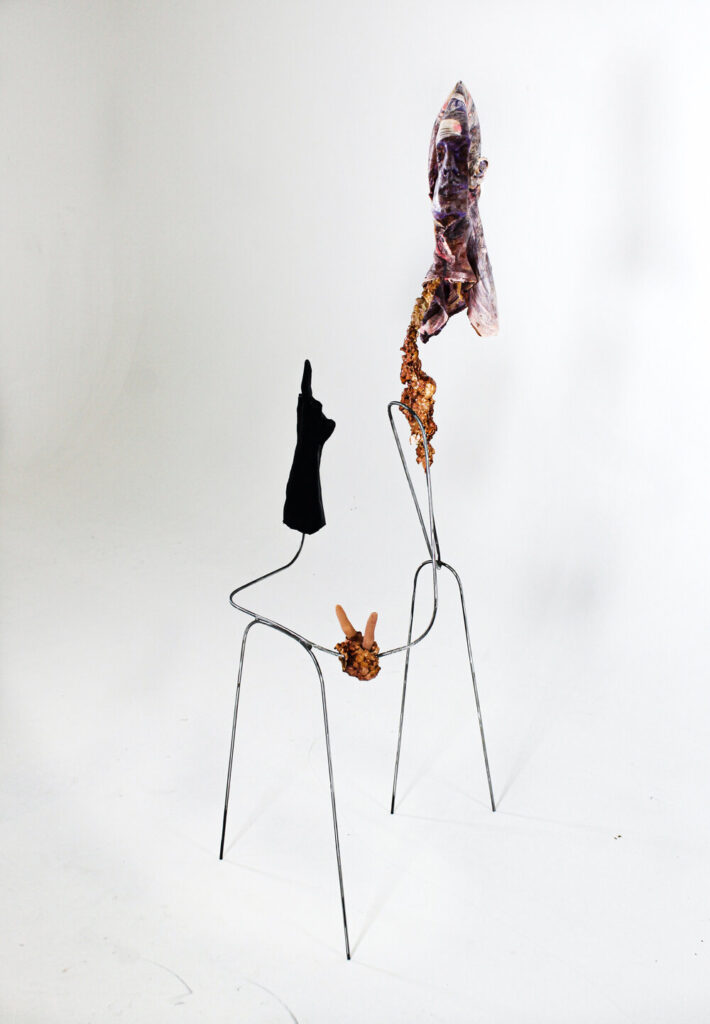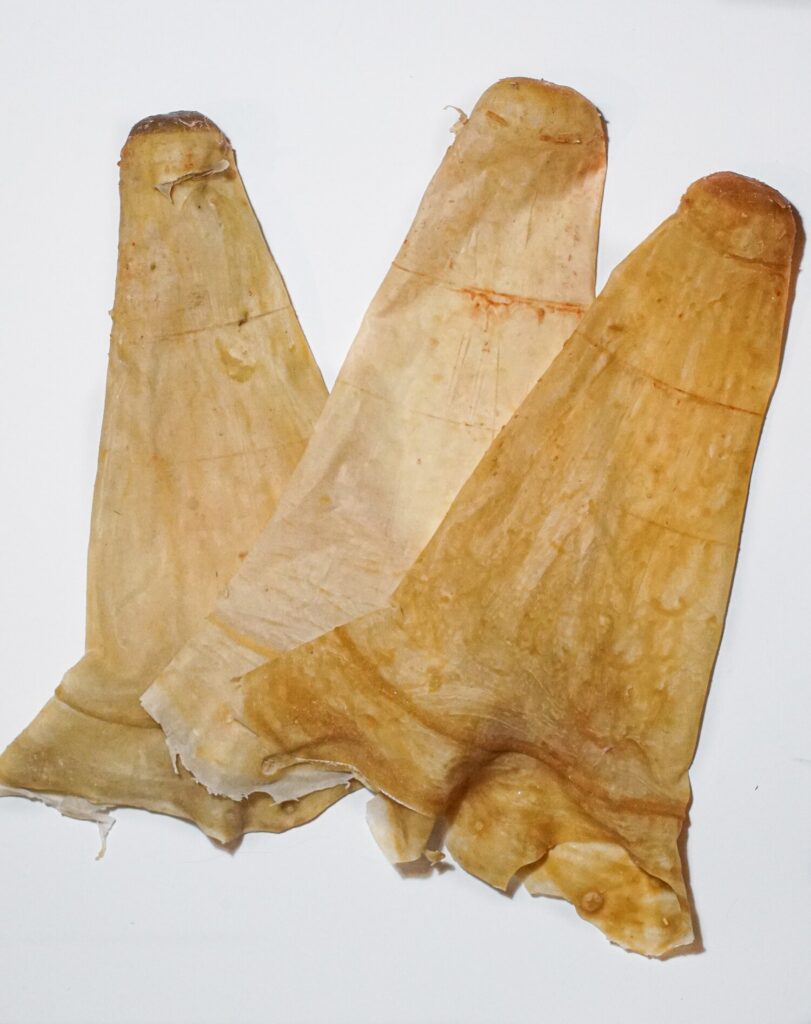After spotting Alexa at the HOME Open Show earlier this year, CONCRETE had no choice but to track down Annabelle Richmond Wright and grill her about her practice. This interview is not for the faint hearted; it contains reference to offices, Zoom quizzes, and pornography.

Detail from Touch Me, I’m Offline, Annabelle Richmond Wright, 2021.
I: How would you explain what you do to someone in the street?
RW: If I was feeling pretentious I’d say ‘I’m an absorber of life’. *laughs* It’s not gonna happen though, is it? I’d say, I’m an artist. I make a mess. I don’t get paid.
I: Why did you start working with the materials you work with?
RW: Every material is loaded with a language. It’s symbolic of something, historical or cultural, that can be changed by the context you give it. Materials evoke a feeling. I like to harness that to allow the materials to speak their message or one I give them.
I: Is your process important to the work?
RW: 100%. I like methodical things – like casting: that’s very methodical. If I’m not enjoying the process, it’s probably the wrong process, because it’s filling my whole day, and I want to love what I’m doing. I like to be intuitive as well. I work both ways. I’ve always loved knowing how things are made. I’ve got a lot of curiosity for the science behind it. When you know how things are made you have more power.
I: How did you start using the materials you use?
RW: Grabbing them. And playing. It’s as simple as that. When I was making Harder, Faster, More, I was like, ‘I’m becoming an engineer now’. *laughs* I never know how to do it when I start, but I want to do it so I figure it out. You learn as you go along. You use your creative problem skills, find a way, or ask someone. The journey is more interesting than the end product, I think.

Harder, Faster, More, Annabelle Richmond Wright, 2021.
I: How did you make Harder, Faster, More?
RW: Six months in the workshop everyday. I saw someone make a conveyor belt on a website for hobbyists with rudimentary things and I took that idea – it’s the same idea, the same cog mechanism and the rollers, the drive belt – but I applied that logic to steel and a conveyor belt.
I: Why are you interested in the experiences of the office worker?
RW: When I left art school the first time, I found myself in an office. I was a Digital Marketing Assistant. Marketing, administration – you’re always in an office. Nurses work in offices. Doctors work in offices. Teachers work in offices. It’s like, what’s left in this world? The first job was really terrible, but the second one was more creative. Still, it wasn’t art. The ideas came to fruition when I left the office and started my degree. I was thinking about my time spent in those offices. Your body isn’t made to sit in a chair all day. My neck hurt, I felt heavy, my circulation was rubbish. I internalised spending time, 9-5, five days a week, in a clinical environment that is not your home or the outdoors as a modern prison. It felt like being inside a computer. It’s so far removed from what we are supposed to be doing.
I: How did you apply this to your work?
RW: The QWERTY series are made out of concrete, wax, ink, and polyester stuffing that was ripped from a computer chair – all materials I encountered working in the office. Living in an office 9-5 five days a week, you spend more time there than at home. It becomes your habitat. I wanted to use concrete to imply that heavy feeling of drudgery, as you may feel working in an office, doing work you aren’t passionate about. Also, their size – they’re massive – they’re like tombstones. The weight of it you can feel on your shoulders.

Alexa with Richmond Wright in their studio. This image is property of Imogen Delbourgo.
I: Alexa won the HOME Open Prize this year. That work touches on similar themes to your Computer Keys.
RW: Alexa is made out of memory foam. I was thinking of women’s bodies being soft. Memory foam has an imprint when you lean on it. It’s a feeling of support. That’s what an assistant does – they support the CEO, a male counterpart.
I: What do you think your gender does in shaping your perception of the office?
RW: When you think of an office assistant you think of porn straight away. I mean, I do. You think of a sexy blonde secretary in high heels in an office. At my first job I was the only young female there. Everyone else was a man. I was working in an industry that’s male dominated; we made industrial ice machines. I remember being on the phone to one of the customers who I think was a sausage manufacturer, or something. My boss, the man who owned the company, turned to me at the end of the call and said “Annabelle, you need to pick up your voice. Speak a little bit high pitch because the customers on the phone want an image of a pretty young woman on the end of the phone”. I was twenty years old. I was already insecure about my deeper voice. For my boss to say that… I couldn’t believe it. I was shocked and upset. Being the only young female it was a bit daunting interacting with my colleagues, too. That was my perception of a woman being in an office – hence why I made Alexa the way she is. That sexualised assistant. It feeds into the idea of dominance and submission which is sexual. Even in your job, you are being submissive to a dominant. In a wider sense, being a female informs everything, really. I see everything through my lens.
I: Why do you think it makes interesting art to explore the office? I really think it does, but there isn’t a wealth of office art.
RW: There are a good few films that are good at depicting office life. It’s interesting because it’s an everyday space. It’s ‘normal’. People spend their lives working at the office. It’s a normal part of Western society – it’s considered quite lucky. It’s aspirational as a white collar job. The materials and objects you find in an office can be easily subverted too, I think. It’s such a bizarre environment, yet so normal.

Enter Key, Richmond Wright, 2021.
I: What is an artwork you wish you’d made first?
RW: I Can’t Help Myself, Sun Yuan & Peng Yu. It’s insane. It’s a robotics wet dream. I saw it at the Venice Biennale in 2019.
I: Which artists do you really like?
RW: I like Paul McCarthy, Frank B and Monster Chetwynd. But I remember after making Alexa I went to a Sarah Lucas exhibition and saw a work she’d made that was similar. I was like, ‘What! It looks like I copied Sarah Lucas! Nooooo!’ I hate when people stuff tights – it’s so Sarah Lucas, or so Senga Nengudi – it’s been done a lot. I love Bruce Numan, too. He’s done everything, hasn’t he? The absurdity, it’s so cynical and horrific and disturbing.
I: He’s one of the godfathers of the avant-garde. Like Hans Haacke.
I: We’ve touched on it, but can you tell me some more about Harder, Faster, More?
RW: Capitalism and BDSM are so similar, I think. There is dominance and submission in capitalism, and obviously in BDSM as well. I was thinking about commodity fetishism. The human body has been commodified and fetishised as an object in capitalism as well as in fetishes in BDSM. Snakeskin is a fetish object. It’s an animal that has been commodified to sell for fashion the same way the body has; women in South East Asia cut off their hair so it can be sold as hair extensions in the UK, that’s why my sculpture uses genuine snakeskin and there is a human hair extension braid as well.
I: There is an insidiousness to capitalism which goes beyond the sterility of the office and is black in its heart, so the black frame that houses the conveyor belt is very fitting.
RW: I was thinking a little about BDSM but I was thinking about war machines more – like the Colossus and Eniac Computers. The first computers in WW1 and WW2 were giant – they’d fill a room – you’d be working inside a computer. That’s where I got the structure of the frame from. It’s that idea of this space being utilised for destruction.
I: If you take it right back, computers were for war, and then when technology became handheld for a brief time it was very exciting. These days I have absolutely no excitement for technology whatsoever – it’s a constant in life that’s getting more and more frightening.
RW: Everyday people in New York would walk past the shop front where the Colossus Computer was, unknowing that behind the false wall of the shop front was this machine for destruction. Today the building is the headquarters for LVMH. The elite haven’t left – they’ve just transformed.
I: Where is Harder, Faster, More?
RW: In my basement, taken apart. I’m gagging to show it in an exhibition. It’s so niche because it’s so big – it’s 1.9 m tall and 1.7 wide – it’s heavy, I’d need a van to take it somewhere. I’ve applied it to stuff but I’ve not got there with it yet.
I: I think it’s only a matter of time.

Touch Me, I’m Offline, image is property of the artist.
I: You’ve also explored the effect of the online age on the human condition with your work. A good example is your Touch Me, I’m Offline. Can you tell me about it?
RW: It’s about the digitisation of ourselves. I made it in my third year of university which was during covid. Obviously, in lockdown, everyone was online. Zoom team meetings, going to university online –
I: When people were doing zoom quizzes.
RW: *laughs* Innit, what was that? There was a phenomenon called ‘skin hunger’ when people were really longing for a physical, human touch – nothing sexual – just a hug. Being within the space of another human. This was during the time when you’d go to the supermarket and people would look at each other suspiciously. Touch Me, I’m Offline was about anxiety and guilt about spreading the virus. I made the fleshy bits of the sculpture particularly abject; it’s gross, and mushy, and sloppy – you don’t want to touch it. The fragmentation of the body is really important, too. I wanted to reflect how we exist online in lots of different profiles or fields and how that’s a kind of scattered version of the self. It can’t be whole. There are pockets of you all over the internet – like when you google yourself and it’s weird which pictures of yourself you end up seeing. We are all chopped into lots of little bits and scattered across the internet.
I: Where does performance fit in your practice?
RW: I’d call them ‘performance happenings’ or ‘object happenings’. I’ve interacted with my objects. For example, typing like I was in an office with my keyboard keys. I did make a piece that I showed live in my living room. *laughs* It was an all female audience and I used my body as a graffiti object, a vessel. I was wearing beige tights and ropes and I gradually took them off and went behind a curtain. There was a voice playing as well, telling the audience to write anything on my body relating to feeling shame about sex and the female experience of sex. Once everybody had written something, I looked at my body and read them out. People wrote stuff like ‘I think I’m gay but I’m ashamed of it. I’ve never been with a girl before’ – all stuff about shame around sex, around periods. There was also a nice discussion after.
I: Will you return to performance?
RW: I think so. I like blending sculpture and installation with performance. That’s really interesting. I like audience participation, too. There is one piece I did that I really like. I made a form that looked like my university had made it. It was dead on – same font, same logo, everything. My uni was really bad for health and safety. If you brought in an object you had to have a health and safety form, and ask this person this and ask that person that. All these things were banned. Anyway, I told my friends I had this performance and asked them to come watch it. When they agreed, I told them, “You have to fill in this form beforehand. Sorry! It’s the uni rules, it’s not me”. So I set up a camera and the audience all filled in this form. The performance was them filling out the form. It’s five minutes of them filling out this form which starts with very typical questions that get more and more ridiculous. No one thought critically – they just did it because it had the uni logo. “What did I have for breakfast?! That’s weird!” but then they’d write it down anyway. It’s like a social experiment. I love that kind of stuff – like how you can walk into any building with a ladder.
I: You’re a teacher. Have you shown your students your art?
RW: A couple, when they’ve asked. They like it. But at sixteen and seventeen, they think it’s a bit strange.

Rubber Johnny, Richmond Wright, 2020.
I: What’s next for you?
RW: I am in the Cotton On In Manchester exhibition. That’s happening from the end of May until the end of June. I’m doing a talk there about my work which I’m looking forward to. I’ve also been commissioned to make a Corgi for the Queen’s Jubilee for Manchester. I’m sworn to secrecy about my idea right now, though. It’s done by Inch Arts, in Altrincham. There’s going to be 50 corgis around Altrincham which is fun.
I: Anything else?
RW: I want to make a new body of work. What’s really on my mind at the minute is interracial relationships because I’m in one. It’s been interesting seeing the cultural clash from my experiences. British Asian, Pakistani Asian, and then white British, coming together… and religion as well. I’ve only got one other friend who’s also with an Asian guy. We’re gonna have a chat soon. It’s only the beginning of an idea so far. I’ve got some bits of faux leather I could work with.
I: I think if anyone was well placed to do this deftly, you are probably the candidate – I can’t lie. You’re gonna tear it apart.
RW: Hopefully. Some things I’ve experienced are very frustrating. Comments from more traditional Asian people made in their own language so I can’t hear it. My husband can understand, so he tells me, and then I’m fuming! No one wants to be stared at.
I: If you could travel in time, where would you go?
RW: I’d definitely go to the future. See what the next million pound idea is. *laughs* Maybe a 100 years time. Not too far, but far enough to see a change. Maybe people are on Mars then. Maybe there are now… yeah, 100-200 years. I’ll let you know how it goes.
All images are property of the artist unless stated otherwise. You can keep up to date with Richmond Wright here.



